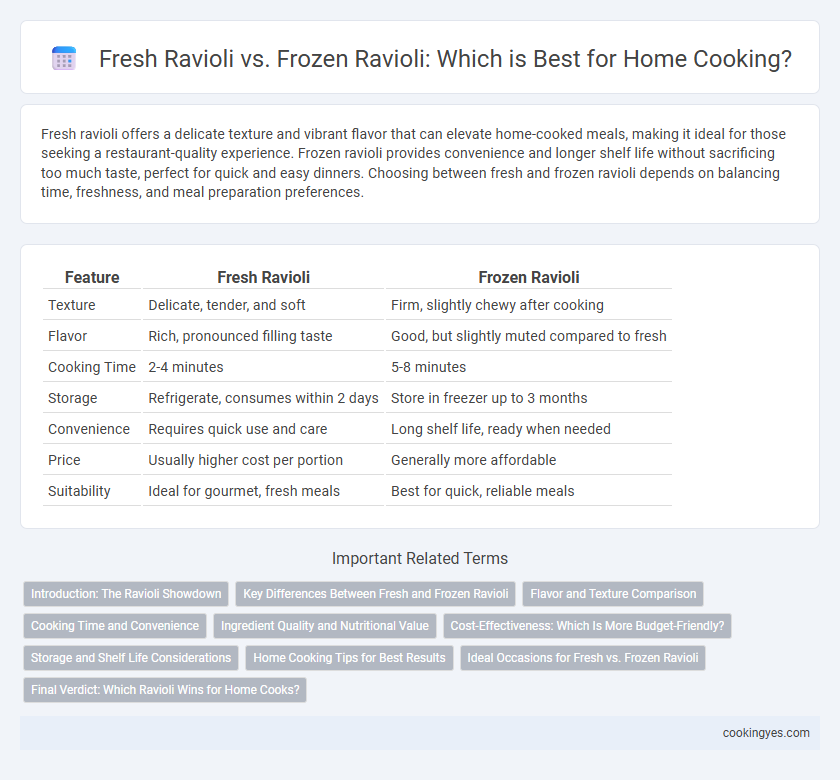Fresh ravioli offers a delicate texture and vibrant flavor that can elevate home-cooked meals, making it ideal for those seeking a restaurant-quality experience. Frozen ravioli provides convenience and longer shelf life without sacrificing too much taste, perfect for quick and easy dinners. Choosing between fresh and frozen ravioli depends on balancing time, freshness, and meal preparation preferences.
Table of Comparison
| Feature | Fresh Ravioli | Frozen Ravioli |
|---|---|---|
| Texture | Delicate, tender, and soft | Firm, slightly chewy after cooking |
| Flavor | Rich, pronounced filling taste | Good, but slightly muted compared to fresh |
| Cooking Time | 2-4 minutes | 5-8 minutes |
| Storage | Refrigerate, consumes within 2 days | Store in freezer up to 3 months |
| Convenience | Requires quick use and care | Long shelf life, ready when needed |
| Price | Usually higher cost per portion | Generally more affordable |
| Suitability | Ideal for gourmet, fresh meals | Best for quick, reliable meals |
Introduction: The Ravioli Showdown
Fresh ravioli offers a delicate texture and enhanced flavor due to its freshly made pasta and filling, making it ideal for gourmet home cooking. Frozen ravioli provides convenience and longer shelf life, preserving taste and quality through quick freezing methods. Home cooks often choose based on time, taste preference, and meal planning needs.
Key Differences Between Fresh and Frozen Ravioli
Fresh ravioli offers a delicate texture and enhanced flavor due to its short shelf life and lack of preservatives. Frozen ravioli provides convenience and extended storage time, retaining quality through flash-freezing methods that preserve taste and prevent freezer burn. Cooking times vary; fresh ravioli cooks faster, typically within 2-3 minutes, while frozen ravioli requires a few extra minutes to ensure thorough heating.
Flavor and Texture Comparison
Fresh ravioli boasts tender pasta and vibrant fillings, delivering a rich, authentic flavor and a delicate, satisfying texture that melts in the mouth. Frozen ravioli offers convenience but may experience slight firmness in pasta and muted filling flavors due to freezing and reheating processes. Choosing fresh ravioli enhances flavor intensity and maintains optimal texture, making it ideal for gourmet home cooking experiences.
Cooking Time and Convenience
Fresh ravioli cooks in just 2 to 4 minutes, offering a quick and tender option for home cooking. Frozen ravioli requires a longer cooking time of 4 to 6 minutes but provides extended shelf life and easy storage. Choosing between fresh and frozen ravioli depends on balancing time efficiency with the convenience of availability and preservation.
Ingredient Quality and Nutritional Value
Fresh ravioli typically contains higher-quality ingredients with fewer preservatives, preserving the natural flavors and nutrients of the fillings such as ricotta cheese, spinach, or meat. Frozen ravioli often undergoes blanching and freezing, which can slightly diminish the nutritional content and alter the texture, but it provides convenience and longer shelf life. Choosing fresh ravioli enhances ingredient integrity and nutritional value, while frozen ravioli offers practical storage without significant nutrient loss if cooked properly.
Cost-Effectiveness: Which Is More Budget-Friendly?
Fresh ravioli typically costs more per pound due to higher quality ingredients and shorter shelf life, while frozen ravioli offers a more budget-friendly option with longer storage potential and less food waste. Home cooks seeking cost-effectiveness often find frozen ravioli advantageous, as bulk purchases and reduced spoilage lower overall expenses. However, fresh ravioli may be preferred for special meals despite the higher cost, balancing quality against budget considerations.
Storage and Shelf Life Considerations
Fresh ravioli requires refrigeration and typically lasts 2 to 3 days when stored properly in an airtight container, making it ideal for immediate consumption. Frozen ravioli can be kept in a freezer for up to 8 months, offering extended shelf life and convenience for meal planning. Proper storage at consistent temperatures is crucial to maintain texture and flavor quality in both fresh and frozen ravioli.
Home Cooking Tips for Best Results
Fresh ravioli offers a tender texture and delicate flavor that enhances home-cooked meals, while frozen ravioli provides convenience and longer shelf life without significant loss in quality. To achieve the best results, cook fresh ravioli in boiling salted water for 2-4 minutes until they float, and gently simmer frozen ravioli for 4-6 minutes, avoiding overcooking to prevent sogginess. Pairing ravioli with light sauces like sage butter or simple marinara highlights their filling and preserves the pasta's texture in home cooking.
Ideal Occasions for Fresh vs. Frozen Ravioli
Fresh ravioli is perfect for special occasions and dinner parties where presentation and texture are paramount, offering a tender, delicate bite with flavorful fillings that elevate gourmet meals. Frozen ravioli excels in convenience and shelf life, making it ideal for quick weeknight dinners or last-minute gatherings without compromising satisfying taste and quality. Choosing between fresh and frozen depends on balancing time constraints with the desired meal experience, ensuring optimal enjoyment for various home cooking scenarios.
Final Verdict: Which Ravioli Wins for Home Cooks?
Fresh ravioli offers a superior texture and flavor profile, making it ideal for home cooks looking to impress with authentic Italian taste and a delicate mouthfeel. Frozen ravioli provides convenient storage and longer shelf life, retaining good quality when cooked properly, which is perfect for quick meals and minimizing waste. For home cooks prioritizing taste and freshness, fresh ravioli wins, while frozen ravioli suits those valuing convenience and time-saving in meal preparation.
Fresh ravioli vs Frozen ravioli for home cooking Infographic

 cookingyes.com
cookingyes.com